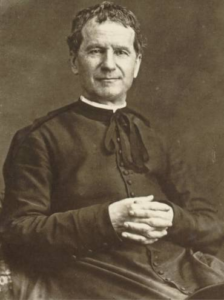January and February
St. John Bosco

Life Dates: 1815-1888
Feast Day: January 31
St. John Bosco is a saint with a style all his own. An Italian priest, who eventually started a religious order, he used his enormous energy and talents to champion the rights of children caught in the miseries of the Industrial Revolution. He provided not only housing and food, but education, job skill training, and spiritual guidance. He even gave hair cuts!
John Bosco is a delightful, for he never lost his childlike sense of fun. He helps today’s children see that we are all called to help those who have been treated unjustly. He is also a good example of hungering to learn.
Juggling Life and Prayer
Young John was enjoying a fair. He watched a magician, a juggler and acrobats very closely. Back at home, John tried doing the magic tricks, handstands and flips, and even practiced walking on a rope! He learned to do each one.
John was always learning. He listened to an hour-long homily at church. At home, he repeated it, word for word! He was full of energy and curiosity. He smiled and laughed often. He worked hard, played hard and sometimes fought with friends.
John decided God wanted him to become a priest. His family was very poor, so when he was old enough to study for the priesthood, he left home in hand-me- down clothes. He also had to have jobs, so he made candy, fixed shoes, and managed a restaurant. He even put on a one-man circus!
At that time, many poor children left their homes on farms, hoping to find work in big cities. The work was too hard for children, and they weren’t paid much. Some children carried bricks up five stories, fifty times a day! Many other children found no jobs. All were hungry, scared and cold, and most had no where to sleep. John knew what it was like to be poor, but this greater suffering touched his tender heart. He knew God was calling him to help them.
So he did magic tricks. He juggled. He even walked on a tight rope.
Of course, the children gathered to watch. Then John gave them food and prayed with them. He worked hard to get houses for them. He found bosses who would teach the children skills to get good jobs. John himself taught them reading, math, art, and writing. He also sang with them, ran races, played football and of course, taught them that God dearly loved them.
Feasting:
In honor of John’s Italian heritage, serve pizza or spaghetti.
Decorating/Activity:
There are photographs of John available on the internet. If you find one that can be copied, do so, put it into a frame and put it on the table.
Tell children that in order to have enough money to feed and house the many children in his care, he stayed up late at night and wrote books. Now your children can make a book about the life of John Bosco. Help children think about aspects of John Bosco’s life before they begin drawing:
- John as a child learning to do handstands, walk a tightrope, or juggle
- Young John listening and memorizing a homily
- John as a young seminarian doing a one-man circus
- John as an adult helping children learn to read, praying with them, cutting boys’ hair, playing ball games with children
Prayer:
Enlist a few readers to help you read this prayer.
Dear God,
Thank you for making St. John Bosco!
He could jump!
He could juggle!
He could stand on his hands!
You made him so wonderful!
He could work hard!
He could pray!
He could teach!
You made him so wonderful!
And he used all these gifts from you to help children.
You made us wonderful too!
Help us learn how you want us to use our gifts too!
Amen.
For more information to celebrate St. John Bosco with prayer, feasting and activities, see A Circle of Saints.
God is Always Near
A Story of St. Josephine Bakhita
Life Dates: 1869-1947
Feast Day: February 8
Life was hard for Bakhita when she was a child. She had to work every day. Some people were very mean to her. She could never play or have friends.
Even though she was not free to go to school or to play, her soul was free to wonder. No one told her about God, but she wondered.
She felt the sun warming her shoulders and saw how it made the gardens grow. And so she wondered who had made the sun.
At night, Bakhita saw the pale moon and the twinkling stars looking down as if they could see her. “Who could have made these wonderful things?” she wondered. “I wish I could know who made them.”
When Bakhita was older, her life changed. She was able to go to a school! There, kind teachers told her about God. Yet, in a way, she already knew God was there, with her. Now she began talking to God through her prayers. Then she decided to get baptized. She chose a new name, Josephine, and added it to Bakhita.
Josephine Bakhita became a sister, or nun. She lived with other sister who taught children. The children loved her. The people in town loved her. The other sisters loved her, for Josephine was always gentle and smiling.
After a childhood of being mistreated, she now spent the whole rest of her life helping others know about God’s love. She did this with gentleness and wise words.
She said, “The Lord has loved me so much! Be good, love the Lord, and pray for those who don’t know him.”
For more information to celebrate St. Josephine Bakhita with prayer, feasting and artwork, see A Circle of Saints.